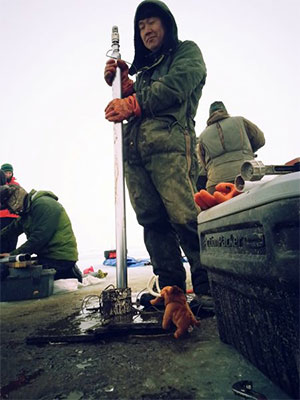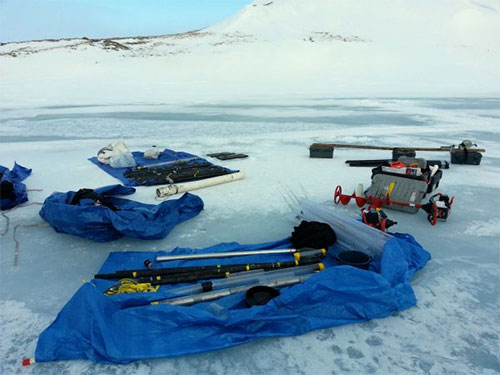
Study: Lack of water likely caused extinction of isolated mammoths in Alaska
August 03, 2016
By analyzing layers of a dated sediment core from a lake on St. Paul Island, researchers determined that mammoths went extinct on the island roughly 5,600 years ago, thousands of years after remnant mainland populations died off. The study also indicated that the Bering Sea island experienced a phase of dry conditions and declining water quality at about the same time the mammoths vanished.
"It's amazing that everything turned out so precisely with dating of extinction at 5,600 plus or minus 100 years," said Russell Graham, professor of geosciences, Penn State who led the researchers. Matthew Wooller, director of the Alaska Stable Isotope Facility at the University of Alaska Fairbanks and a co-author of the study, said past events on St. Paul Island provided a unique opportunity for research. Mammoths were trapped there when rising sea levels submerged the Bering Sea land bridge, and survived about 5,000 years longer than remnant mainland populations. There is no evidence of people having lived on the island during the era. St. Paul Island lies about 400 miles north of the Aleutian Islands and was part of the Bering Land Bridge before sea level rose when the last glacial period ended. Previous researchers radiocarbon-dated remains of five mammoths to about 6,480 years ago, but there was no way to know if these were the last five animals. Beside the mammoths, the only animals appearing on the island in "prehistoric" times were arctic foxes, shrews and polar bears, and there is no evidence of polar bears before 4,000 years ago. Humans did not arrive on the island until 1787 C.E. The only large mammals present were mammoths. In 2013, a team of researchers collected a sediment core from the bed of one of the few freshwater lakes on St. Paul Island. Wooller and fellow UAF researcher Kyungcheol Choy measured the stable oxygen isotope ratios of the prehistoric remains of aquatic insects preserved in the sediment from before, during and after the extinction of mammoths from the island. "We see a reduction in the three species of fungus, all of which are associated with the dung of large animals," said Graham. "These spores are a marker for the presence of large animals like mammoths." Sediment DNA from the lake cores showed the presence of mammoth DNA until 5,650 years ago, plus or minus 80 years. After that time, there is no mammoth DNA and so no mammoths on the island. The youngest of the newly dated mammoth remains' dates fall within the mammoth DNA range and the fungal spore dates as well. Using state-of-the-art methods for radiocarbon dating, the researchers used 14 newly recovered remains from various areas on the island to help document the time of extinction.
Equipment for collecting samples of lake sediment is laid out as part of a research project on St. Paul Island.
The remains of aquatic organisms living in lakes retain water isotope signatures within their bodies, which allowed researchers studying their exoskeletons to determine that lake levels had diminished. The remains of diatoms and aquatic invertebrates from the core also changed over time, indicating decreasing lake levels and water quality leading up to the mammoth extinction. Nitrogen isotope analyses of dated mammoth bones and teeth also signaled progressively drier conditions leading up to the extinction event. Wooller said these “multiple lines of evidence” of decreasing lake levels provide a strong case for what led to the animals’ extinction. “It paints a dire picture of the situation for these mammoths,” Wooller said. “Freshwater resources look like the smoking gun for what pushed them into this untenable situation.” The study not only determined one of the best-dated prehistoric extinctions, using state-of-the-art techniques on ancient mammoth DNA preserved in the lake core from St. Paul Island, it also showed the vulnerability of small island populations to environmental change. St. Paul Island gradually shrank to its current size of 110 square kilometers as sea levels rose, reducing the opportunities for mammoths to find new areas with water. Conditions incrementally changed for about 2,000 years before mammoths went extinct. The shrinking of the island concentrated the mammoths in a smaller area and diminished available water. Pollen from the lake cores indicate that the area around the lake was denuded of vegetation by the mammoths. Like elephants today, when the water became cloudy and turgid, the mammoths probably dug holes nearby to obtain cleaner water. Both of these things increased erosion in the area and helped fill in the lake, decreasing the available water even more. After the extinction of the mammoths, the cores show that erosion stopped and vegetation returned to the area. In essence, the mammoths contributed to their own demise. The researchers note that this research "highlights freshwater limitation as an overlooked extinction driver and underscores the vulnerability of small island populations to environmental change, even in the absence of human influence," Modern climate change could shift conditions more rapidly, which could make the story of prehistoric St. Paul Island relevant today, Wooller said. The researchers used a variety of proxies to date the demise of the mammoths on the island. Proxies are things in the environment that can be used to independently document the presence of an organism, even though they are not parts of it. In this study, three different spores from fungi that grow on large animal dung were extracted from lake cores and used to determine when the mammoths were no longer on the island. Proxies in sediments from cores from a lake near the cave were used to determine the time of the demise of the mammoth population. The researchers also used environmental proxies to investigate habitat changes at the time of extinction. The island, which formed between 14,700 and 13,500 years ago rapidly shrank until 9,000 years ago and continued slowly shrinking until 6,000 years ago and now is only 42 square miles in area. While large animals like mammoths became extinct on the continents about 12,000 years ago due to climate change and habitat restructuring, the process was different on the island. The project included a collaborative group of researchers from across the U.S. and Canada, led by Russ Graham from Pennsylvania State University. It included contributions from a UAF team that included Wooller, Choy, Ruth Rawcliffe and Emilie Saulnier-Talbot. Beth Shapiro and Peter Heintzman of the University of California, Santa Cruz, analyzed mammoth DNA from the St. Paul Island lake core. The work was supported by a grant from the National Science Foundation.
Reporting & Editing by Mary Kauffman, SitNews
Source of News:
Representations of fact and opinions in comments posted are solely those of the individual posters and do not represent the opinions of Sitnews.
|
||||


